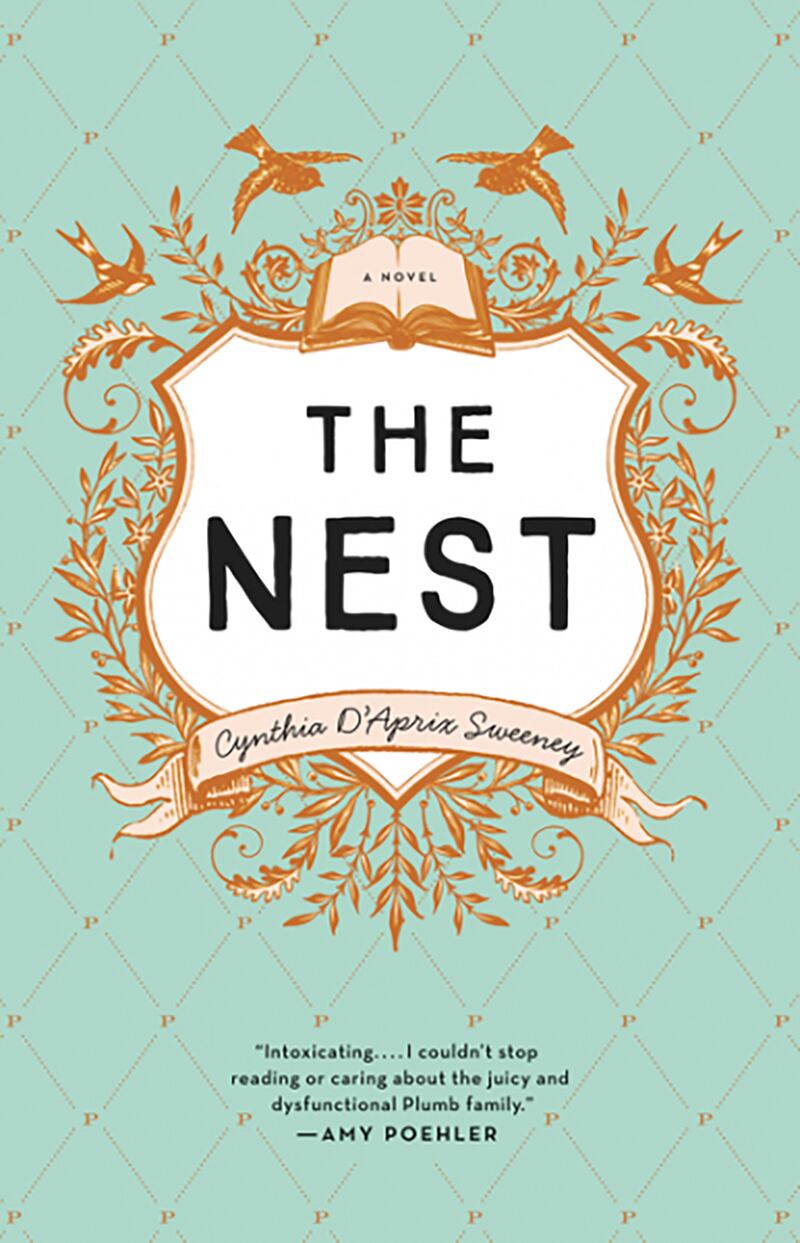The Nest—a first novel by a woman, a bright-lighted family story—offers the kind of pleasure I’ve been missing all these years I’ve been assigned prodigious novels of dark ideas by established men such as Gaddis, Pynchon, DeLillo, Wallace, and Vollmann. An additional pleasure: The Nest came to me by luck, sent by some ill-informed publicity director who thought I might like such a book, “ill-informed” because I don’t recall ever praising a novel like The Nest. I was curious, gave it an hour, and then the rest of the day, speeding through all 350 pages of Sweeney’s novel. It was like binge-watching a cable TV series. In fact, The Nest reminded me of early episodes of Netflix’s Bloodline, also about siblings’ inheritance imperiled by a ne’er-do-well brother. The Nest is not just about money—a multi-million dollar trust fund—but is being promoted by money, the million-dollar advance the publisher proudly announced was paid for this first novel by an unknown writer. Sweeney and some other recent debut novelists who have been paid huge advances seem to be shaping a new genre for fledgling writers.
The patriarch of Sweeney’s Plumb family created a trust to be shared equally by his four children when the youngest, Melody, turns 40. A Westchester housewife, she needs the money to send her twin daughters to college. Jack, the Greenwich Village antiques dealer, wants the money to keep his business afloat. Bea, the struggling writer working in Brooklyn, could use the money to quit her tedious editing job. And Leo, the downtown Manhattanite, doesn’t need the money because he secretly stashed a couple million in the Caymans after he sold his business. But when Leo—high on coke and driving uninsured with his penis in the hand of a 19-year-old girl—has an auto accident that costs the girl a foot, the Plumbs’ mother, Francine, who has power over the trust all the siblings call “the nest,” uses most of the money to buy the girl’s silence. Leo keeps his stash secret while making a half-hearted attempt to pay back his siblings. Humorous and then serious conflicts ensue, first between con-man Leo and his siblings, then among the siblings and their spouses after Leo disappears. Like a four-ball juggler, Sweeney keeps her Plumbs in the air, adds several more characters, and makes readers wonder chapter to chapter which one will drop first.

Francine taps the trust to prevent “gossip” among her Long Island friends. Ironically, Leo made his fortune, most of which he has blown, by creating a Gawker-like gossip magazine. The further irony of The Nest is that its page-turning pleasure depends on the all-knowing Sweeney’s method of creating character with high-toned gossip. Sweeney’s model seems to be her fiction writer Bea, who has early success with literary magazines by retailing stories about young Leo, a predictable mix of embarrassing fact and realistic distortion. Although characters in The Nest are in crisis—Melody’s family may lose their house, Jack and his husband Walter may lose their summer home, one twin is worried about being gay—the novel keeps its readers comfortable because its discourse promises that nothing horrible will happen to characters who exist in the realm of authorial gossip. Shameful secrets will surely be revealed, but none of the Plumbs are going to lose an appendage. At times the novel may seem like a nest of ninnies but never a nest of vipers, and the endings Sweeney gives her characters deliver on the book’s promise of safe haven. Two learn how to give up their nests, their homes, and others begin relationships that will create new nests.
The pat endings broke the spell for me. I recognized—belatedly, I admit—that The Nest is not really about character. Sweeney may not have intended her title to refer to the security provided by her gossipy style, but paging back through the novel, I realized that I never had to worry about coming upon some disturbing sensibility, original metaphor, syntactical oddity, evidence of an intricate pattern, mysterious allusion, or alien setting. No, The Nest is formed from familiar twigs to hold in fledgling readers who cheep for their next helping of plot from the pre-digesting mother/author. That’s when I remembered the money. To pay out a million dollars for The Nest, the publisher must have calculated that it is as secure a commodity as the novel is a safe fiction for readers.
I understand the economic strategy: a novelist with no history (of mediocre sales) can be publicized as the Big New Find because the author has been given a Big Old Advance. But I worry that Sweeney’s book and some other fairly recent first novels with huge advances—Chad Harbach’s The Art of Fielding, Matthew Thomas’s We Are Not Ourselves, and Garth Risk Hallberg’s City on Fire—suggest young writers are creating what I’ll call commercialit. All of these novels have at least one character who is either an English teacher or a writer, the existence of whom in the text implies that the novel must be literary. But the literariness of the four is a patina of fictional sophistication scumbled over conventional and therefore commercial components. Even if the characters don’t end up well, at least some readers do—entertained, unthreatened, and pleased to feel they’ve not been reading commercialock: commercial schlock.
Perhaps what I’m describing used to be called “middlebrow” fiction, but the four MFA-holding authors work in just enough evidence of literary knowingness—which gives a high tone to the gossip of The Nest—to make their novels commercialit. Harbach constantly refers to Melville, Thomas uses phrases from contemporary poets as titles for his several parts, Hallberg alludes to other novelists of New York. When Sweeney’s Bea visits the apartment of a contemporary who has become much more successful than Bea, she sees on the other woman’s bookshelves novels by Pynchon, Beckett, Roth, and Bellow—and then finds the “well-thumbed, stained pages” of a “celebrity weight-loss book.” Bea gleefully reports this bit of gossip to Leo, but Sweeney doesn’t seem to realize that while The Nest does not have the “lurid purple spine” of the weight-loss book, the novel is also not likely to be shelved “between Mythologies and Cloud Atlas.” The six writers referred to are male, but I don’t think the issue of Sweeney’s shelving is gender. Given the examples of Harbach, Thomas, and Hallberg, the issue is provender, what will put food on the table, what might make a first novelist as successful and rich as the woman writer that Bea visits.
I appreciated The Nest much less after I realized what it had in common with The Art of Fielding, We Are Not Ourselves, and City on Fire, books I perhaps mistakenly measured against the work of their truly literary—original and unpredictable and even dangerous—forebears whom I mentioned earlier. I don’t begrudge Sweeney her million and her millions (maybe) of readers, but I hate to think readers might mistake a commercialit novel for a literary novel. I believe that Sweeney, Harbach, Thomas, or Hallberg could have written one (City on Fire comes closest, We Are Not Ourselves the furthest) but chose not to. For all I know, the writers have twins going to college or collapsing businesses or accident victims to pay off. But if novels such as The Nest are promoted as and mistaken for true literary work, actual literary writers will have increased difficulty getting their books published, for editors can say, “Look, look, we’re satisfying our cultural responsibilities.” Something like Gresham’s Law—bad (or debased) money drives out good—will govern literary production with the good driving out the great or, at least, the attempt at greatness.
I’m not in favor of anhedonia. Those cranky old Russian Formalists said art consisted of defamiliarization. Sweeney and the others offer the pleasure of refamiliarization. I think that pleasure is emotional and recalls the nest, being read to by an adult. The pleasure of defamiliarization is cognitive (no, not necessarily intellectual; perceptual or experiential will do) and recalls the experience of reading for oneself: “Aha, those unfamiliar marks on the page are words that make a world!” The novelists on the successful writer’s shelf and the novelists I’m usually assigned (and let’s add women writers such as Rachel Kushner, Jennifer Egan, Dana Spiotta, Siri Hustvedt) provide that cognitive pleasure. And as long as we’re talking about money, their books offer a better investment because they give that pleasure when reread and read again. I’ve read Beckett and Pynchon a dozen or more times. I can quote passages, and yet the works as wholes remain unfamiliar, even uncanny, the Freudian unheimlich, which was translated as “the not at home.” Not of and in the nest.
If I sound elitist, please consider that, like Sweeney’s characters, I, too, have a problem with my inheritance. No matter how much I can appreciate the craft of new commercialit, I can’t ultimately avoid comparing it with the artlit I inherited in fifty years of reading. One of my trust-creating patriarchs is William Gaddis, who wrote several novels about inheritance; J R and A Frolic of His Own won the National Book Award for fiction. Despite his prizes and the admiration of other literary novelists, Gaddis was never paid for a single book what Sweeney has received for her first novel. His first novel, The Recognitions, was a commercial failure for decades even as it was being recognized as a masterwork of contemporary American fiction. I couldn’t help but think about Gaddis’s first novel about inheritance after finishing Sweeney’s. Her skill—and it’s considerable—was to make me forget Gaddis when I was reading her. But recovered from my binge of refamiliarity, I had my recognition of the difference between an artisanal nest and an artistic novel. Sweeney’s Plumbs are in a way impoverished by always thinking about their inheritance. So am I, for my knowledge of novels by writers such as Gaddis ultimately deprives me of the kind of pleasure that writers such as Sweeney seek to provide. I just have to hope that the money publishers make on books like The Nest and We Are Not Ourselves (which became a bestseller) trickles down to—is “inherited” by—novelists willing to fly from the nest of conventional story and high-toned gossip.






